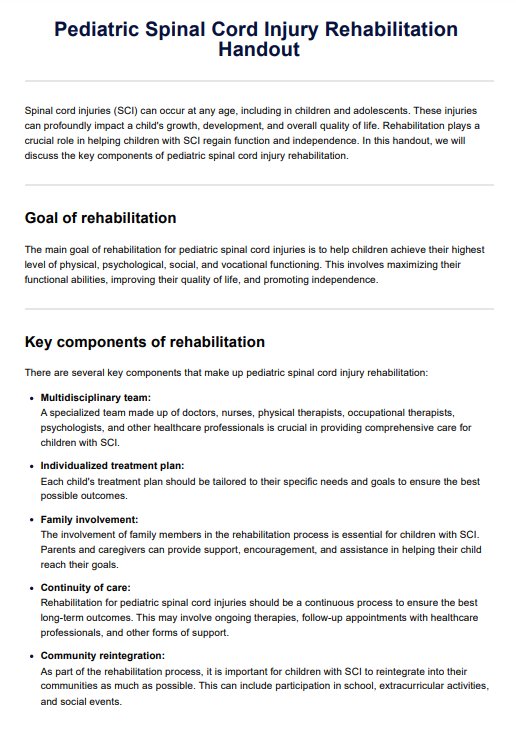Pediatric Spinal Cord Injury Rehabilitation Handout
Download Carepatron's free PDF handout on pediatric spinal cord injury rehabilitation featuring valuable information for your patients.


What is a pediatric spinal cord injury?
Spinal cord injury (SCI) refers to damage to the spinal cord that disrupts the communication between the brain and the rest of the body. These injuries can be classified as either traumatic spinal cord injuries or non-traumatic injuries. Traumatic spinal cord injuries often result from events such as motor vehicle accidents, falls, or sports-related incidents. In children, cervical spine injuries are particularly concerning due to their vulnerability during play and physical activities. Spinal cord injuries affect various bodily functions, including movement, sensation, and autonomic functions like bowel and bladder control.
In the context of pediatric rehabilitation, children with spinal injuries may experience significant challenges, such as spinal shock, which can temporarily impair neurological functions. Rehabilitation programs, including a comprehensive spinal cord injury program, focus on physical therapy to help children regain mobility and independence. Effective interventions aim to improve bowel and bladder function, promoting overall quality of life.
Symptoms of spinal cord injuries in children
Children with spinal cord injuries may exhibit various symptoms, including muscle weakness and partial or complete loss of muscle movement in the chest, arms, or legs. Breathing difficulty is another significant symptom, often indicating the severity of the injury. These children might also experience partial or complete loss of sensation in the affected areas, such as the chest, arms, or legs. Additionally, loss of bowel and bladder function is a common issue, further complicating their condition.
Diagnosis of a pediatric spinal cord injury
Diagnosing a pediatric spinal cord injury involves several diagnostic tests, including CT scans, MRIs, or X-rays. These imaging tests allow doctors to closely examine abnormalities within the spinal cord. A CT scan provides detailed cross-sectional images, while an MRI offers high-resolution images of the spinal cord and surrounding tissues. X-rays are typically used to identify fractures or dislocations.
Pediatric Spinal Cord Injury Rehabilitation Handout Template
Pediatric Spinal Cord Injury Rehabilitation Handout Example
Treatment of spinal cord injuries in children
Treating spinal cord injuries in children requires a comprehensive and multi-faceted approach. Immediate and long-term treatments aim to stabilize the injury, prevent further damage, and support the child's recovery and rehabilitation. Below are key aspects of the treatment process.
Immobilization
Immediately after a spinal cord injury, immobilization is crucial to prevent further damage. This involves using braces, cervical collars, or spine boards to keep the spine in a stable position. Proper immobilization helps minimize movement, protecting the spinal cord from additional harm.
Supportive care
Supportive care includes managing the child's overall health and addressing complications arising from the injury. This may involve maintaining respiratory function, ensuring proper nutrition, and preventing infections. Pain management and monitoring for signs of spinal shock are also vital components of supportive care.
Surgery
In some cases, surgery may be necessary to stabilize the spine, remove bone fragments, or repair damaged tissues. Postsurgical rehabilitation is essential for recovery, involving continued physical therapy, occupational therapy, and other supportive measures to aid in the child's return to daily activities and improve their overall well-being.
Rehabilitation of pediatric spinal cord injuries
The effects of SCI on a child's body are often more severe compared to adults due to their developing nervous system and smaller body size. Rehabilitating pediatric spinal cord injuries is an essential aspect of managing the condition and promoting the child's overall well-being.
This process involves a multidisciplinary approach, including medical, physical, occupational, and psychological interventions. The goal of rehabilitation is to maximize the child's functional abilities and independence while minimizing complications and secondary health conditions.
To learn more about rehabilitation of PSCI, download our Pediatric Spinal Cord Injury Rehabilitation Handout.
How will professionals benefit from our handout?
Carepatron's Pediatric Spinal Cord Injury Rehabilitation Handout outline the key components of a rehabilitation program for children with spinal cord injuries. It also includes different approaches that healthcare professionals can use in providing the most comprehensive care for their pediatric patients.
Here are some of the other benefits of this handout:
Fully digital
Our handout is easily accessible in digital form, making it easy for professionals to refer back to the information at any time.
Comprehensive guidelines
The handout provides detailed guidelines on offering comprehensive physical and mental care for pediatric patients with spinal cord injuries.
Tailored specifically to the pediatric population
Unlike general rehabilitation programs, our handout takes into consideration the unique needs of children with spinal cord injuries. This allows healthcare professionals to provide specialized care that is tailored to their young patients' specific needs.
Easy to customize
You can edit the handout to include your facility's specific protocols and procedures, making it a useful tool for training new staff members.
Commonly asked questions
A pediatric spinal cord injury is treated through a combination of immediate immobilization, supportive care, and long-term rehabilitation. This may include physical therapy, occupational therapy, and sometimes surgical interventions to stabilize the spine and improve function.
Rehabilitation in spinal cord injury typically includes three phases: acute, subacute, and chronic. The acute phase focuses on stabilization, the subacute phase on initial recovery and functional training, and the chronic phase on long-term rehabilitation and reintegration into daily life.
Rehabilitation after a spinal cord injury can vary widely but generally lasts several months to a year or more. The duration depends on the severity of the injury, the individual’s progress, and the specific rehabilitation goals.
Regaining movement after a spinal cord injury involves intensive physical therapy and rehabilitation exercises designed to strengthen muscles and improve motor control. Additionally, advanced techniques like electrical stimulation and adaptive equipment can support recovery and enhance functional mobility.







































































































